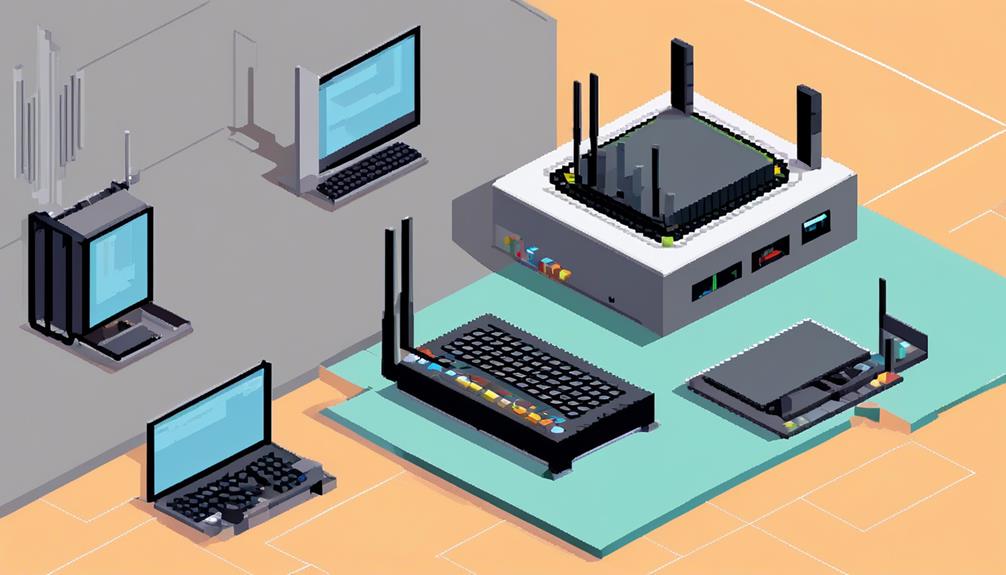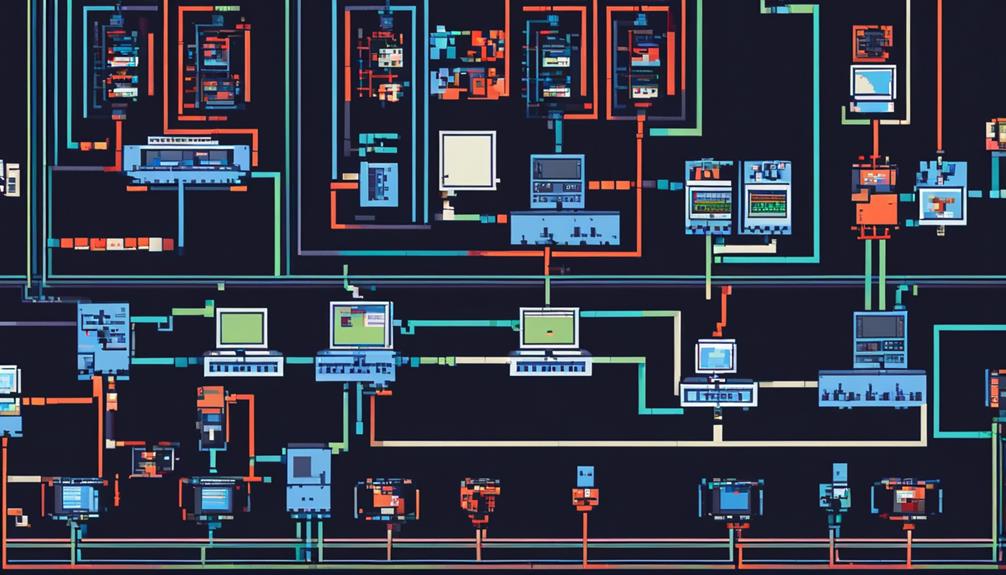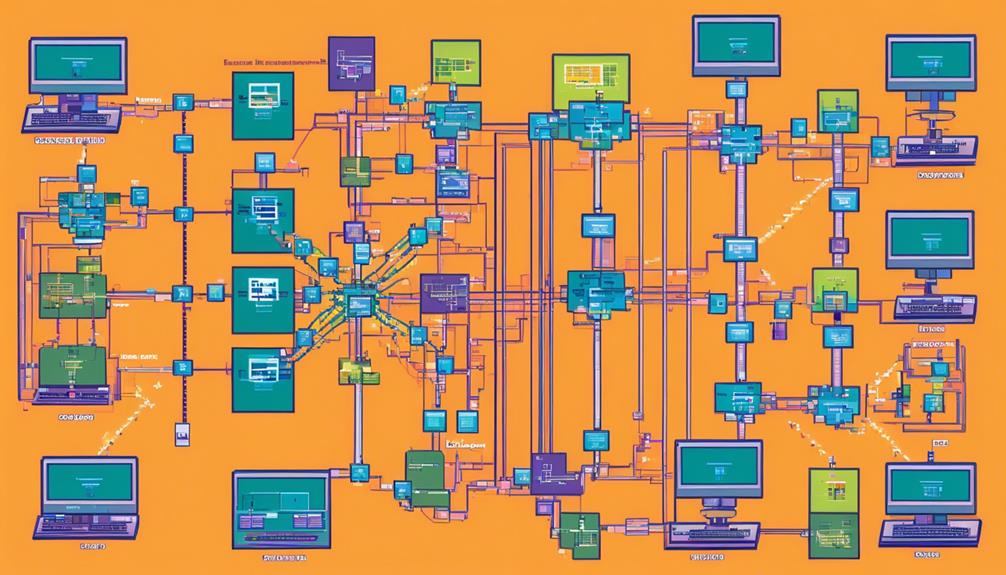In today's interconnected world, the security of wireless networks is of paramount importance. Organizations rely on secure wireless network hardware to safeguard their sensitive data and protect against unauthorized access. From strategically placed access points to network switches, firewalls, and routers, each component plays a critical role in establishing a secure network infrastructure.
However, the complexity and scalability of enterprise Wi-Fi setups require additional considerations, such as WLAN controllers, PoE switches, and backup solutions for uninterrupted connectivity.
In this discussion, we will explore the fundamentals of secure wireless network hardware, delve into the selection process for the right wireless router and access points, discuss the implementation of Power over Ethernet (PoE), and highlight the importance of network management and monitoring for maintaining a robust security posture.
Furthermore, we will uncover best practices for regular firmware updates and security audits to ensure the ongoing integrity of wireless network hardware.
By the end of this discourse, you will have gained valuable insights into the crucial aspects of securing wireless networks and be equipped with the knowledge to fortify your organization's network infrastructure.
Key Takeaways
- Encryption and password protocols are crucial for wireless network security.
- Regular firmware and security patch updates help mitigate vulnerabilities and protect against cyber attacks.
- Strong firewalls and access control measures, such as MAC address filtering, should be implemented on routers and access points.
- Network segmentation and VLANs can isolate sensitive data, preventing unauthorized access.
Wireless Network Security Basics

Wireless network security basics encompass essential measures such as encryption, firewalls, and professional assistance to ensure the secure transmission of data and protect against unauthorized access. Encryption is a critical component of wireless network security as it converts data into a format that can only be understood by authorized parties. By using encryption algorithms, wireless networks can prevent eavesdropping and unauthorized access to sensitive information.
Firewalls or routers play a crucial role in wireless network security by controlling the flow of traffic between the wireless network and the internet. They act as a barrier, inspecting incoming and outgoing network packets and blocking any unauthorized or suspicious activity. Firewalls can be configured to allow or deny specific types of traffic based on predefined rules, thereby enhancing the overall security of the network.
Setting up and configuring a secure wireless network can be a complex task, requiring professional assistance. Network security experts have the knowledge and expertise to design and implement secure wireless networks, ensuring that access points are properly configured, encryption protocols are correctly implemented, and firewalls are appropriately set up. They can also assist in creating a security policy tailored to the specific needs of the wireless network, outlining guidelines for network usage, password management, and data protection.
Regularly updating firmware and software is crucial for wireless network security. Manufacturers frequently release updates to address vulnerabilities and improve the overall security of their wireless network devices. By keeping the firmware and software up to date, network administrators can mitigate potential risks and ensure the network remains secure.
Importance of Secure Network Hardware
Secure network hardware plays a critical role in safeguarding sensitive data and preventing unauthorized access.
Implementing robust encryption and password protocols is necessary to ensure the security of wireless networks.
Regularly updating network equipment with the latest firmware and security patches is crucial to mitigate vulnerabilities and protect against potential cyber attacks.
Hardware Security Measures
Implementing robust hardware security measures is vital for safeguarding sensitive data and ensuring the integrity and confidentiality of wireless network systems. To achieve this, the following measures should be considered:
- Access Points:
- Access points should be equipped with strong encryption protocols, such as WPA2 or WPA3, to protect data in transit.
- Implementing MAC address filtering can restrict access to authorized devices only, adding an extra layer of security.
- Routers:
- Routers should have strong firewalls in place to control traffic flow and block unauthorized access attempts.
- Enabling features like network segmentation and VLANs can isolate sensitive data, preventing unauthorized access.
Network Vulnerability Prevention
To ensure the continued protection of sensitive data and prevent unauthorized access, robust network hardware security measures must be in place. Network vulnerability prevention is crucial in maintaining the integrity and confidentiality of wireless network access. Firewalls and routers act as the first line of defense by filtering and inspecting incoming and outgoing traffic, blocking any suspicious or malicious activity. Additionally, enterprise Wi-Fi setups require advanced hardware solutions to handle the complexity and scalability of the network, ensuring robust security measures are implemented. Quality of Service (QoS) features prioritize network traffic, optimizing performance and resource allocation. Power over Ethernet (PoE) switches provide power to access points, simplifying installation and ensuring uninterrupted connectivity. By implementing these hardware solutions, organizations can mitigate the risks of network vulnerabilities and protect their wireless network devices and data.
| Security Measures | Description |
|---|---|
| Firewalls | Block unauthorized access and filter network traffic |
| Routers | Control traffic flow within the network |
| Advanced Hardware Solutions | Handle complexity and scalability of enterprise Wi-Fi setups |
| Quality of Service (QoS) Features | Optimize performance and resource allocation |
| Power over Ethernet (PoE) Switches | Provide power to access points and ensure uninterrupted connectivity |
Selecting the Right Wireless Router

When selecting the right wireless router, it is crucial to consider the range requirements and potential obstacles that may impact signal strength. Here are some factors to consider:
- Range requirements: Determine the coverage area needed for your wireless network. Consider factors like the size of the space, the number of devices that will be connected, and any potential areas where the signal may be weak or obstructed.
- Obstacles: Identify potential obstacles that can impede the signal strength, such as walls, floors, and other physical barriers. Thick walls or metal structures can significantly reduce the range of your wireless network.
It is important to select a wireless router that can effectively overcome these challenges and provide a reliable and robust wireless network.
When evaluating wireless routers, consider the following:
- Security features: Ensure that the wireless router has robust security features, such as encryption and firewalls, to protect your network from unauthorized access and data breaches. This is especially important if you are dealing with sensitive or confidential information.
- Hardware requirements: Assess the hardware requirements to support the scalability and complexity of your wireless network. This includes access points, switches, and network management tools. Choose a router that can accommodate the number of devices and users on your network without compromising performance.
- Quality of Service (QoS): Prioritize wireless routers with QoS features that allow you to prioritize network traffic based on specific criteria. This helps optimize network performance and ensures that critical applications receive the necessary bandwidth.
- Power over Ethernet (PoE) switches: Consider using PoE switches to provide power to access points. This eliminates the need for separate power supplies and ensures uninterrupted connectivity for your wireless network.
Choosing Secure Wireless Access Points
When it comes to choosing secure wireless access points, two important points to consider are encryption protocols and access control mechanisms.
Encryption protocols ensure that data transmitted over the wireless network is secure by encrypting it in a way that only authorized parties can decipher.
Access control mechanisms, on the other hand, help prevent unauthorized access to the network by implementing authentication and authorization processes.
Encryption Protocols for APs
It is essential to select secure wireless access points that support robust encryption protocols such as WPA2, WPA3, or WPA3 Personal to ensure the secure transmission of data over wireless networks.
When choosing encryption protocols for APs (Access Points), consider the following:
- Compatibility: Ensure that the encryption protocols are compatible with the wireless network adapters and devices that will connect to the network. This compatibility will ensure seamless and secure communication between the devices and the access points.
- Advanced Encryption Features: Look for access points that offer advanced encryption features to protect the network from potential security threats. These features may include encryption key rotation, secure authentication mechanisms, and resistance to brute-force attacks.
Access Control Mechanisms
To ensure the secure transmission of data over wireless networks, it is crucial to select wireless access points with robust access control mechanisms. Access control mechanisms help restrict unauthorized access to the network and protect against potential security threats. There are several key access control mechanisms that should be considered when choosing secure wireless access points:
| Access Control Mechanisms | Description |
|---|---|
| MAC address filtering | Restricts access to authorized devices only by allowing or denying access based on the MAC address of the device. |
| Encryption protocols | Utilizing strong encryption protocols such as WPA2 or WPA3 enhances wireless network security by encrypting the data transmitted over the network. |
| Secure authentication methods | Setting up a secure authentication method, like using strong passwords, adds an extra layer of protection by ensuring only authorized users can access the network. |
| Regular software and firmware updates | Regularly updating access point software and firmware is crucial to address security vulnerabilities and protect against emerging threats. |
Implementing Power Over Ethernet (PoE)

The implementation of Power over Ethernet (PoE) revolutionizes the installation and management of network devices by enabling the simultaneous transmission of power and data over a single Ethernet cable. This technology simplifies the deployment of wireless networks, particularly when it comes to access points for Wi-Fi connectivity.
Here are some key points to consider when implementing PoE:
- Simplified installation: With PoE, there is no longer a need for separate power outlets near access points. This eliminates the complexity and cost associated with running additional electrical wiring. Instead, a single Ethernet cable can provide both power and data, making installation quicker and more efficient.
- Remote powering: PoE allows for remote powering of devices, providing flexibility in the placement of access points. This means that access points can be installed in locations that may not have easy access to power outlets, such as ceiling mounts or outdoor areas. This flexibility simplifies network management by allowing access points to be placed strategically for optimal coverage.
- Power budgets: PoE switches come in various power budgets, ensuring compatibility with different types of access points and other PoE-enabled devices. This allows for scalability and customization based on the specific needs of the wireless network. Whether deploying a small office network or a large enterprise network, there are PoE switches available to meet the power requirements of the access points.
Integrating Firewall for Network Protection
Integrating a firewall into the network hardware is a critical step in ensuring comprehensive protection against unauthorized access and potential security breaches. With the increasing reliance on wireless network access, it becomes imperative to implement robust security measures to safeguard against potential threats. By integrating a firewall into the network infrastructure, organizations can effectively control traffic flow and block unauthorized access attempts.
A firewall acts as a barrier between the internal network and external networks, such as the internet. It monitors and filters incoming and outgoing network traffic based on predefined security rules. This ensures that only authorized users and devices can access the network, while potential threats are blocked.
In the context of wireless networks, where multiple access points are utilized to provide seamless connectivity, the integration of a firewall becomes even more crucial. It allows for centralized control and management of network traffic, ensuring consistent security policies across all access points. This helps prevent any potential vulnerabilities in the network from being exploited.
Securing Wireless Network Switches

Securing wireless network switches is a crucial aspect of comprehensive network protection, especially in the context of integrating a firewall into the network hardware. To ensure the security of wireless network switches, the following measures should be implemented:
- Encryption protocols: Use strong encryption protocols such as WPA2 or WPA3 to protect wireless network switches from unauthorized access. These protocols provide secure authentication and encryption of data transmitted over the network, preventing unauthorized individuals from intercepting and accessing sensitive information.
- Authentication methods: Implement secure authentication methods, such as using strong passwords or certificate-based authentication, to enhance the security of wireless network switches. Strong passwords should be complex and regularly changed to minimize the risk of unauthorized access.
Regular firmware updates are also essential to secure wireless network switches. Manufacturers release firmware updates to address vulnerabilities and improve network security. By regularly updating the firmware with the latest security patches, potential security risks can be mitigated.
Monitoring wireless network switch traffic is another crucial aspect of securing the network. By monitoring network traffic, suspicious activity or unauthorized devices can be identified promptly, allowing network administrators to take immediate action to mitigate potential security threats.
Additionally, disabling or removing unnecessary network services and features on wireless network switches reduces the attack surface and minimizes security risks. By eliminating unnecessary services, the potential entry points for attackers are reduced, making it more difficult for them to gain unauthorized access to the network.
Enhanced Security With VPN Solutions
Enhancing the security of wireless networks can be achieved with the implementation of VPN solutions, which provide an additional layer of protection through the encryption of internet traffic and secure remote access for employees. By using VPN solutions, businesses can safeguard sensitive data and communications from unauthorized access. VPN hardware ensures secure remote access for employees working from outside the office, allowing them to connect to the network in a protected manner.
One of the key features of VPN solutions is the encryption of internet traffic. When data is transmitted over a wireless network, it can be intercepted by malicious individuals. However, with the use of VPN, the data is encrypted, making it unreadable to anyone without the decryption key. This ensures that sensitive information, such as login credentials or financial data, remains secure.
Another security benefit of VPN solutions is secure remote access. Employees who need to work from outside the office can connect to the network securely through a VPN. This prevents unauthorized access to the company's resources and ensures that only authorized individuals can access sensitive information. Additionally, VPN solutions often provide two-factor authentication, adding an extra layer of security by requiring users to provide a second form of verification, such as a unique code sent to their mobile device.
Implementing VPN solutions is a proactive approach to mitigating security risks and protecting the integrity of the wireless network. By encrypting internet traffic and providing secure remote access, businesses can ensure that their data and communications remain confidential and protected from unauthorized access. Table below illustrates the advantages of VPN solutions in enhancing wireless network security.
| Advantages of VPN Solutions | |
|---|---|
| Encryption of internet traffic | Protects sensitive data |
| Secure remote access for employees | Prevents unauthorized access |
| Two-factor authentication | Adds an extra layer of security |
| Proactive approach to mitigating security risks | Protects network integrity |
| Safeguards data and communications | Ensures confidentiality |
Importance of Intrusion Detection Systems (IDS)

Intrusion Detection Systems (IDS) are crucial components of a wireless network's security infrastructure. By continuously monitoring network traffic, IDS can detect and alert administrators to suspicious activities or unauthorized access attempts.
Implementing IDS provides an additional layer of defense against potential cyber attacks, enhancing the overall security posture of the wireless network.
IDS Benefits
An Intrusion Detection System (IDS) is a crucial component of secure wireless network hardware, providing real-time detection and response to potential security threats.
The benefits of implementing IDS are numerous:
- Proactive monitoring and protection: IDS offers continuous monitoring of network traffic, detecting and responding to potential security breaches in real-time. This minimizes the risk of unauthorized access and data breaches, ensuring the integrity and confidentiality of network data.
- Identification and mitigation of vulnerabilities: IDS provides valuable insight into network traffic and patterns, aiding in the identification and mitigation of potential vulnerabilities or suspicious activities. By analyzing network behavior, IDS can detect patterns indicative of attacks and take appropriate action.
Incorporating IDS into wireless network infrastructure allows organizations to achieve compliance with industry regulations and standards, enhancing the overall security posture and trustworthiness of the network.
IDS plays a critical role in bolstering the security framework of wireless networks, safeguarding against both known and emerging threats to ensure uninterrupted business operations.
Network Security Enhancement
With the implementation of an Intrusion Detection System (IDS), organizations can significantly enhance the security of their wireless network infrastructure by proactively monitoring network traffic and swiftly responding to potential security breaches.
IDS play a critical role in identifying and mitigating various threats, including malware, unauthorized access attempts, and abnormal network behavior. By continuously monitoring network traffic, IDS can detect any suspicious activities that may indicate a security breach.
This enables administrators to take immediate action to prevent further damage and minimize the impact of the breach. IDS can be deployed at various points within the network, including wireless access points, routers, or access points, allowing for comprehensive monitoring of network traffic.
Protecting Network With Authentication and Encryption
Authentication and encryption are essential measures that ensure the security of a wireless network by allowing only authorized users to access it and protecting transmitted data.
Authentication:
- Wireless networks employ various authentication methods to verify the identity of users before granting access.
- This can include usernames and passwords, digital certificates, or even biometric authentication.
- When a user attempts to connect to a wireless network, they must provide the correct credentials or pass through an authentication server that verifies their identity.
- This process ensures that only authorized individuals can join the network.
Encryption:
- Once a user is authenticated, the next step is to protect the data transmitted over the network.
- Wireless routers and access points use encryption protocols, such as WPA2 (Wi-Fi Protected Access 2) or the more secure WPA3, to encrypt data packets.
- Encryption algorithms scramble the data, making it unreadable to anyone without the decryption key.
- This ensures that even if someone intercepts the data, they cannot understand its contents.
By implementing strong authentication and encryption measures, wireless networks can safeguard against unauthorized access and protect the confidentiality and integrity of transmitted data.
However, it's important to note that these measures alone are not sufficient. Regularly updating firmware and security patches on network devices is crucial to address potential vulnerabilities. Additionally, educating users about best practices for wireless network security and raising awareness about potential risks can help maintain a secure environment.
Implementing Network Segmentation

Network segmentation is a crucial strategy for enhancing the security and performance of a wireless network. By dividing the network into smaller subnetworks, known as VLANs (Virtual Local Area Networks), organizations can isolate different types of network traffic, thereby reducing the attack surface and containing the impact of security breaches. This approach creates barriers that restrict unauthorized access and prevent lateral movement within the network.
Implementing network segmentation in a wireless environment brings several benefits. Firstly, it enhances network security by providing more granular control over access and security policies. Each VLAN can have its own set of access controls, ensuring that only authorized users can connect to specific parts of the network. This segmentation prevents unauthorized users from gaining access to sensitive data or critical network resources.
In addition to improving security, network segmentation also optimizes network performance. By reducing broadcast traffic, which is limited to a specific VLAN, network resources are utilized more efficiently. Moreover, resource allocation can be optimized based on the requirements of each VLAN, ensuring that critical traffic is prioritized.
To implement network segmentation in a wireless network, organizations must configure their wireless access points (WAPs) to support VLANs and assign each WAP to the appropriate VLAN. This can be achieved through the use of VLAN tagging protocols such as IEEE 802.1Q. Additionally, network administrators must configure the switches and routers to properly route traffic between VLANs while enforcing access controls.
Securing Wireless Network Management
Effective management of a wireless network requires robust security measures to safeguard against unauthorized access and ensure continuous connectivity. To achieve this, certain hardware components and features play a crucial role in securing wireless network management.
- Network Management Tools:
- Network management tools are essential for monitoring and controlling the wireless network securely.
- These tools provide administrators with real-time visibility into network traffic, allowing them to detect and respond to any potential security threats promptly.
- They also enable administrators to configure and manage network settings, ensuring optimal performance and security.
- Quality of Service (QoS) Features:
- Quality of Service features prioritize network traffic based on predefined rules, ensuring critical data and applications receive adequate bandwidth and minimizing the risk of network congestion.
- By implementing QoS, administrators can prioritize network traffic for secure network management, guaranteeing a consistent and reliable user experience.
- Power over Ethernet (PoE) Switches:
- Power over Ethernet switches provide power to wireless access points, eliminating the need for separate power sources.
- This ensures uninterrupted connectivity even during power outages, preventing potential security vulnerabilities caused by network downtime.
- Additionally, PoE switches simplify the installation process, reducing the number of cables required and making network management more efficient.
- Redundancy Measures:
- Redundancy measures, such as backup power supplies, are essential for securing wireless network management and ensuring continuous connectivity.
- These measures provide failover support in case of power failures or equipment malfunctions, maintaining network availability and security.
- By implementing redundant hardware components, administrators can mitigate the impact of any potential disruptions and maintain a secure wireless network.
Secure Wireless Network Monitoring

Secure wireless network monitoring is crucial for maintaining network security and controlling network access. Network management tools are essential for monitoring and controlling the network, ensuring data security, and managing overall network performance. These tools allow network administrators to monitor and analyze network traffic, identify potential security threats, and respond to them promptly.
One important aspect of secure wireless network monitoring is the implementation of Quality of Service (QoS) features. QoS prioritizes network traffic based on specific criteria, such as bandwidth requirements and network congestion levels. By prioritizing critical network traffic, QoS ensures better performance for important applications and services, while maintaining network security.
Regularly monitoring network activity and conducting periodic security assessments are also crucial for secure wireless network monitoring. This allows network administrators to detect any suspicious or unauthorized activities and respond to them promptly. By monitoring network traffic, administrators can identify anomalies, such as unusual data transfers or unauthorized access attempts, and take appropriate actions to mitigate potential security risks.
Implementing network monitoring tools and incident response procedures is essential for quickly addressing any wireless network breaches and maintaining network security. These tools provide real-time visibility into the network, allowing administrators to monitor network performance, detect security incidents, and respond to them effectively. Incident response procedures ensure that appropriate actions are taken to contain and mitigate the impact of security breaches.
Best Practices for Network Firmware Updates
To maintain network security and optimize performance, regular updates of network firmware are essential.
By ensuring that network devices are equipped with the latest firmware, organizations can address security vulnerabilities and enhance the overall functionality of their network infrastructure.
Additionally, it is crucial to verify compatibility, back up configurations, schedule updates during off-peak hours, and thoroughly test updates in a controlled environment to minimize disruptions and identify any potential issues before deploying them in the production network.
Importance of Updates
Regularly updating firmware of network devices is a critical practice for maintaining the security and efficiency of a wireless network. Here are the key reasons why updates are so important:
- Security enhancements: Firmware updates help address vulnerabilities and ensure the latest security features are installed, reducing the risk of cyber attacks. Neglecting updates can leave network devices vulnerable to security breaches and unauthorized access.
- Performance improvements: Firmware updates not only address security issues but also provide new features, bug fixes, and performance enhancements. These updates contribute to the overall stability and reliability of the network, ensuring optimal performance.
Keeping network devices up to date with the latest firmware is an essential best practice for maintaining secure wireless network hardware. It is crucial for network administrators to regularly check for updates and install them promptly to ensure the ongoing protection and efficiency of the network.
Ensuring Network Security
Implementing proper network security measures includes:
- Ensuring the timely and thorough updating of network firmware. Regularly updating firmware is crucial to address security vulnerabilities in secure wireless network hardware. By keeping network devices up to date, organizations can protect their wireless connections from potential threats.
- Enabling network encryption, such as WPA2 or WPA3, helps safeguard data transmitted over the network.
- Creating strong passwords for network access and periodically changing them to enhance network security.
- Disabling remote management capabilities prevents unauthorized access, further securing the network.
- Enabling network logging allows organizations to keep track of network activity and identify potential security breaches.
Regular Network Security Audits

Performing regular network security audits is an essential practice for organizations to assess vulnerabilities and ensure the overall security of their wireless network infrastructure. These audits involve comprehensive assessments of the network infrastructure, security policies, and configurations to identify potential weaknesses and gaps in security. By conducting regular security audits, organizations can proactively address security issues, comply with regulations, and mitigate potential risks to their wireless networks.
During a network security audit, a thorough evaluation of networking devices such as routers, access points, and switches is conducted. This evaluation involves examining the firmware and software versions to ensure they are up to date and free from known vulnerabilities. Additionally, the configuration of these devices is reviewed to verify that proper security measures, such as strong passwords and encryption protocols, are in place. Auditors also analyze the wireless internet connectivity, ensuring the use of secure protocols and robust authentication methods.
In addition to evaluating networking devices, security audits also assess the effectiveness of security policies and procedures. This includes reviewing access control mechanisms, user permissions, and network segmentation. Auditors examine firewall rules, intrusion detection and prevention systems, and other security controls to ensure they are configured correctly and actively monitoring network traffic.
The findings and recommendations from network security audits guide organizations in implementing necessary security controls and measures to protect their wireless network infrastructure. By regularly assessing vulnerabilities, organizations can identify and address potential security gaps, ultimately enhancing the overall security resilience of their wireless networks.
Frequently Asked Questions
How Do I Secure My Wireless Network?
To secure your wireless network, there are several key steps you can take.
First, ensure that your Wi-Fi network is encrypted using a strong encryption protocol such as WPA2. This will protect your network from unauthorized access.
Additionally, it is important to choose a strong password for your wireless network, combining upper and lowercase letters, numbers, and special characters.
Regularly update your network equipment's firmware and consider implementing additional security measures such as MAC address filtering and disabling SSID broadcasting.
What Is the Most Secure Method for Wireless Network?
The most secure method for wireless network involves implementing strong encryption protocols such as WPA2 or WPA3 to protect data transmission.
By ensuring that the network is properly secured, the benefits include safeguarding sensitive information and preventing unauthorized access.
However, it is crucial to address common vulnerabilities in wireless networks such as weak passwords or outdated firmware.
Educating users on best practices and regularly updating security measures are essential for maintaining a secure wireless network.
What Is Wireless Network Hardware?
Wireless network hardware refers to the physical components required to establish and maintain a wireless network. This includes access points, network switches, routers, and firewalls.
Access points are strategically placed to provide coverage in large areas, while switches deliver the connection and may also provide power through Power over Ethernet (PoE) technology.
Routers and firewalls ensure data security, and network management tools and Quality of Service (QoS) features help monitor and control network traffic.
Compatibility between these hardware components is crucial for a secure and efficient wireless network.
What Is Considered a Secure Wi-Fi Network?
A secure Wi-Fi network is one that employs wireless network encryption to protect data from unauthorized access.
It also utilizes Wi-Fi password protection to prevent unauthorized users from connecting to the network.
Additionally, network intrusion detection systems are implemented to detect and prevent any malicious activities on the network.
These measures ensure that the Wi-Fi network is secure and that sensitive information is safeguarded from potential threats.
